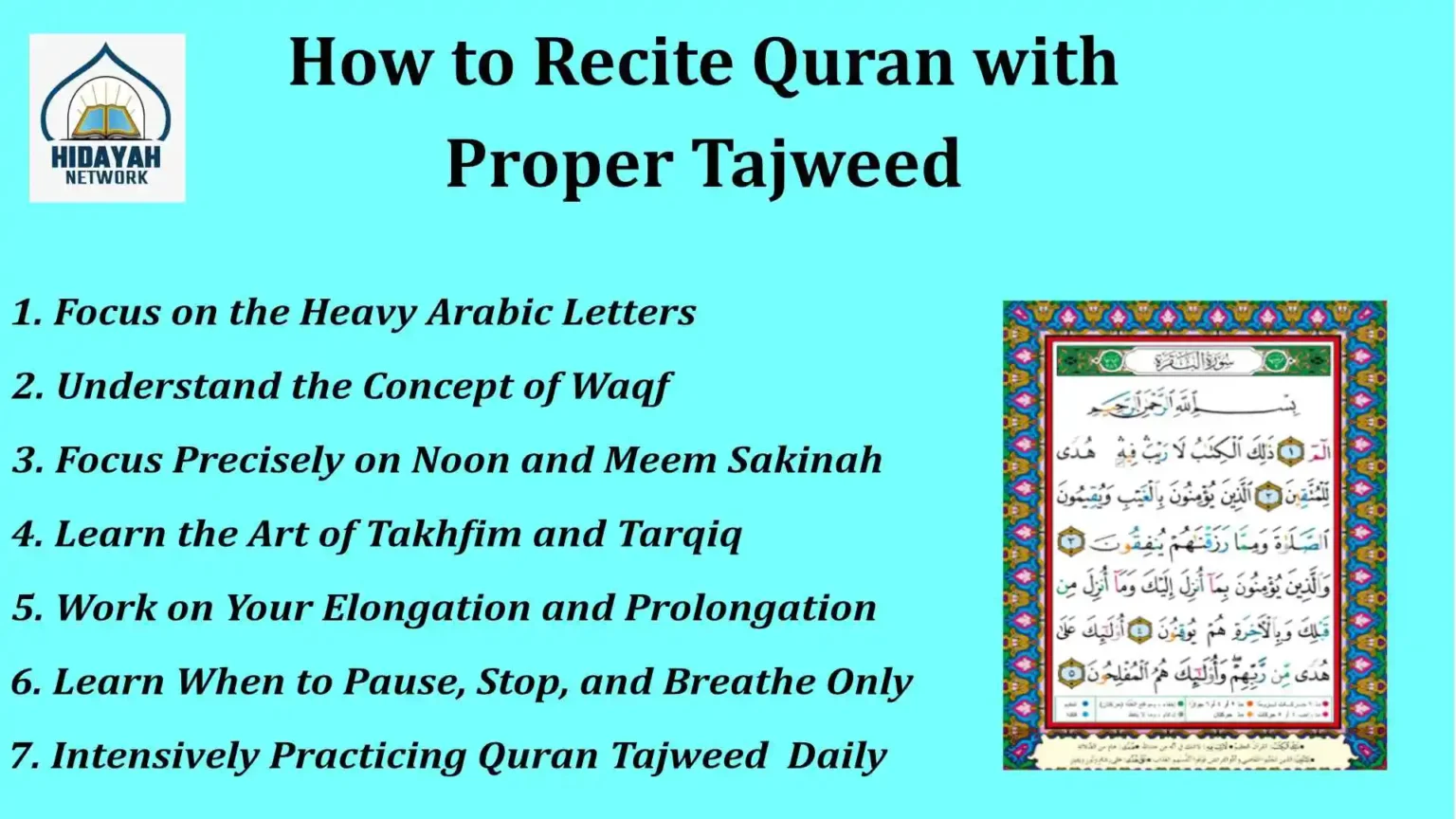Learning to recite the Quran with Tajweed is vital. It helps with avoiding reciting mistakes and misrepresentations of the Quranic text. With the incorporation of Tajweed rules, you can recite the Quran with clarity and beauty, respecting its divine essence. We will help you learn how to recite the Quran with proper Tajweed so you can beautify Allah’s words.
Reciting the Quran with proper Tajweed involves focusing on heavy Arabic letters, understanding the concept of Waqf, focusing precisely on Noon and Meem Sakinah, learning the Takhfim and Tarqiq, etc.
7 Proven Ways to Recite the Quran with Proper Tajweed
Let us be your guiding light in this journey of how to learn Tajweed easily. Here’s what you need to do to implement all these in your daily life.
1. Focus on the Heavy Arabic Letters
Mastering the art of reciting the Quran with proper Tajweed involves understanding the distinct pronunciation of heavy Arabic letters. These letters, like Qaaf, Daad, and Qalqalah letters, require deeper emphasis, influencing the pronunciation and duration of the sounds.
For instance, the letter “Qaaf” demands a deep guttural sound originating from the back of the throat. Understanding and differentiating these heavy letters is crucial to learn Tajweed fast, ensuring the correct enunciation and duration. By focusing on these unique characteristics.
Get 40% OFF Now!
2. Understand the Concept of Waqf
Comprehending the concept of “Waqf” is pivotal. Waqf refers to proper pausing or stopping at specific points while reciting the Quran. For example, recognizing where to stop for a breath or pause while maintaining the meaning of the verse is essential.
Learning the rules of Waqf enables the reader to convey the intended message accurately and avoid altering the meaning by stopping at the wrong point. This profound understanding of when and where to pause ensures not only adherence to Tajweed rules but also a more comprehensive and accurate recitation of the Quran.
3. Focus Precisely on Noon and Meem Sakinah
Tajweed emphasizes precise articulation, especially with Noon (ن) and Meem (م) Sakinah, the non-vocalized, closed-mouth letters. Mastery over Noon and Meem Sakinah requires proper pronunciation and lengthening of these sounds when followed by specific letters.
For instance, when Noon Sakinah or Tanween is followed by a ‘Ba’, ‘Mim’, or ‘Waaw’, elongating the sound for two counts is necessary. Similarly, Meem Sakinah elongation rules vary when followed by certain letters. All of these tajweed rules can be only learned in the tajweed for Beginners course to understand and practice tajweed from the beginning.
4. Learn the Art of Takhfim and Tarqiq
A fundamental aspect of Tajweed is the mastery of Takhfim (nasalization) and Tarqiq (clear articulation). Takhfim involves slightly nasalizing the sound of certain letters like “Ayn,” “Ghayn,” “Qaaf,” and “Kaaf.” Practicing the distinct nasal quality of these letters ensures precision in recitation. Conversely, Tarqiq involves clear and distinct pronunciation of letters without nasalization.
Learning and applying these nuanced techniques of Takhfim and Tarqiq greatly contribute to a more accurate and melodious recitation of the Quran in adherence to proper Tajweed rules.
5. Work on Your Elongation and Prolongation
Enhancing the recitation of the Quran with proper Tajweed involves a keen focus on elongation and prolongation. Elongation, often marked by a “Madd” sign, requires lengthening specific letters. For instance, the “Madd” letters like “Alif,” “Waw,” and “Ya” are elongated for an extended duration, signifying their significance in the recitation.
Prolongation, on the other hand, entails sustaining the sound of specific letters without an elongation sign. Understanding and practicing these distinctions are crucial.
6. Learn When to Pause, Stop, and Breathe Only
A significant aspect of proper Tajweed revolves around knowing when to pause, stop, or breathe while reciting the Quran. This includes recognizing places for mandatory stops (Waqf), where a natural pause or breath is permissible without altering the verse’s meaning.
Understanding the rules of when to pause for a breath and where to stop is crucial. For instance, stopping at the end of a verse or at specific punctuation marks like a comma, full stop, or a verse-ending sign is essential.
7. Intensively Practicing Quran Tajweed Daily

Daily practice forms the backbone of mastering the art of reciting the Quran with proper Tajweed. Consistent and focused practice sessions contribute significantly to honing one’s skills. This includes regular exercises focusing on specific rules and applying them during recitation.
For example, practicing the pronunciation of letters, applying elongation and pause rules, and refining the pronunciation of heavy letters intensively aid in improving one’s Tajweed. Additionally, reciting under the guidance of a qualified tutor or using Tajweed resources ensures corrections and enhances proficiency.
Learn to Recite Quran with Tajweed Online

To learn the art of reciting the Quran with proper Tajweed, seeking guidance from qualified Tajweed tutors is invaluable. Hidayah Network stands out as an exceptional solution, offering comprehensive support for learners at every level, from beginners to those seeking an advanced Tajweed course. Hidayah Network caters to the specific needs of individuals striving to learn tajweed online properly.
Final Words
Mastering the recitation of the Quran with proper Tajweed is not merely a task but a journey of dedication and learning. This profound art of enunciating the divine scripture requires a keen understanding of intricate rules and guidelines.
From emphasizing heavy Arabic letters to comprehending the subtleties of elongation, pause, and nasalization, each aspect contributes to an accurate and melodious recitation. Furthermore, the significance of consistent practice and guidance from proficient tutors cannot be overstated.
Most Important FAQs
Learning Tajweed is crucial as it ensures the Quran is recited accurately, preserving the original message. It maintains the sanctity of the Quran’s words and facilitates a deeper understanding and connection with the divine scripture.
Reading the Quran without mistakes involves learning Tajweed rules meticulously. To achieve this, practice regularly, focus on accurate pronunciation, and seek guidance from a qualified Quran tutor to correct errors.
Beginners can improve fluency by starting with simple verses, practicing regularly, and gradually increasing the complexity. Listening to expert recitations and reciting slowly with proper Tajweed aids in developing fluency over time.
Reciting the Quran with Tajweed preserves the originality of the words and meanings as intended by Allah. It ensures accurate pronunciation, enhances understanding, and adds a spiritual and melodious touch to the recitation.
While Tajweed as a technical science isn’t explicitly mentioned, the Quran emphasizes the importance of reciting it accurately and beautifully. The Prophet Muhammad emphasized proper pronunciation and enunciation, indirectly highlighting the significance of Tajweed.

About Author

